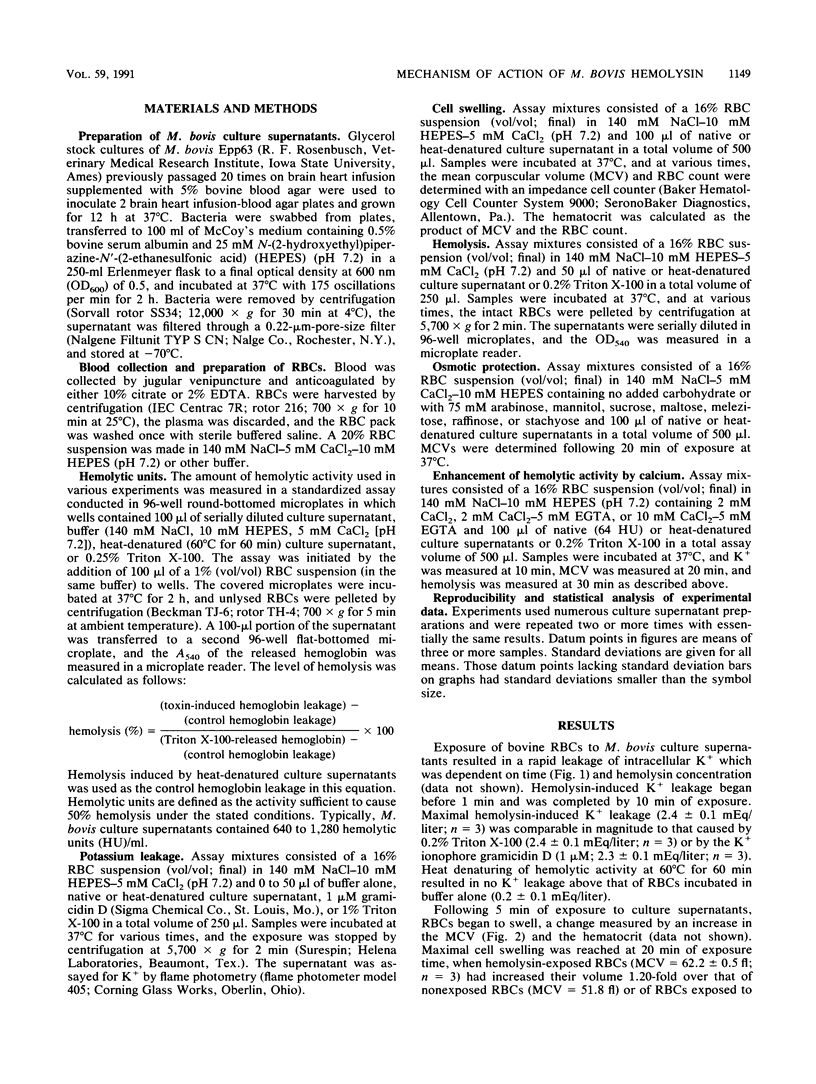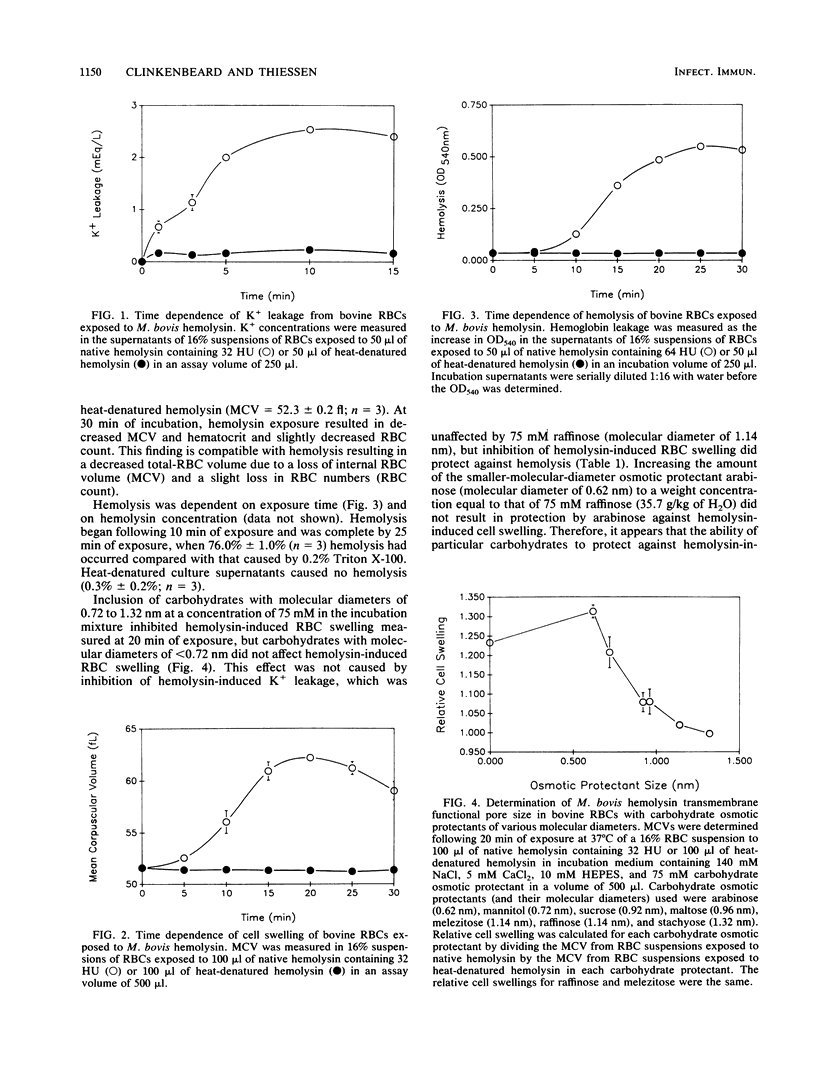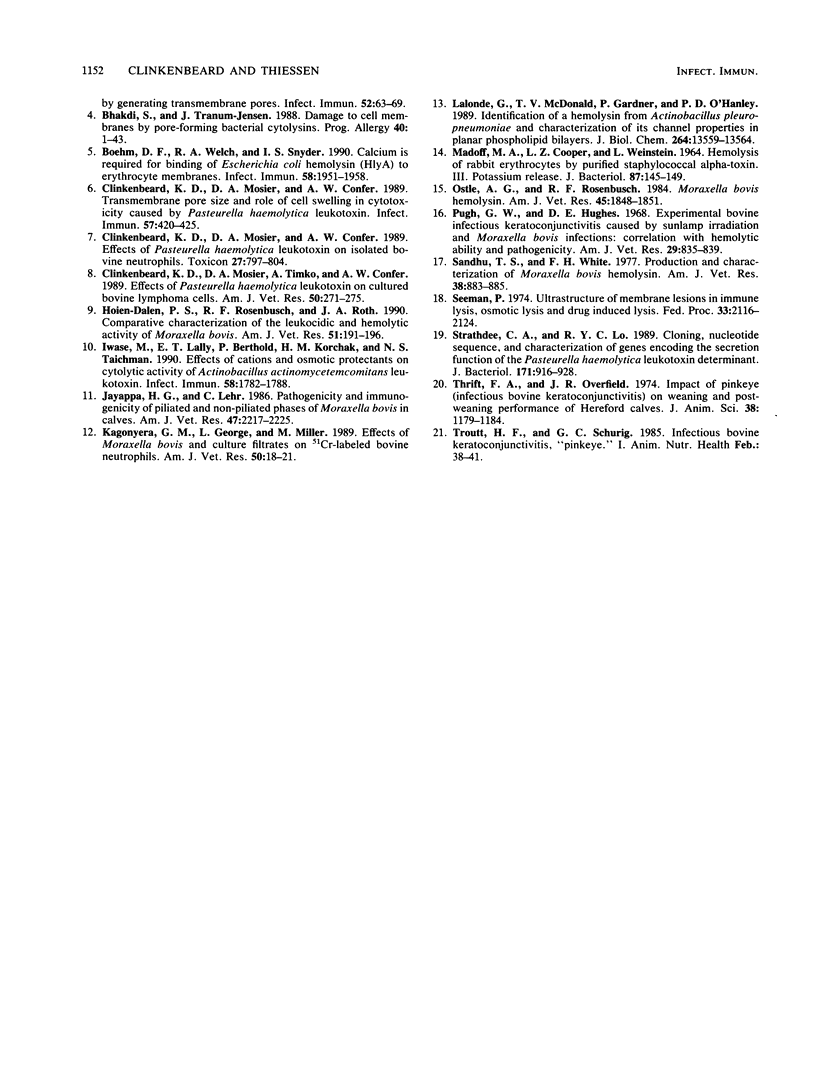Abstract
Bovine erythrocytes (RBCs) exposed to Moraxella bovis culture supernatants exhibited rapid leakage of intracellular K+ (95% in 10 min), slower cell swelling (1.20-fold increase in mean corpuscular volume in 20 min), and subsequent lysis (76% leakage of hemoglobin in 25 min). Incubation media made hypertonic by the addition of 75 mM carbohydrates with molecular diameters of 0.72 to 1.32 nm prevented hemolysin-induced RBC swelling, but incubation media made hypertonic by the addition of carbohydrates with molecular diameters of less than 0.72 nm did not protect against hemolysin-induced RBC swelling. Raffinose (75 mM; molecular diameter, 1.14 nm) did not block hemolysin-induced K+ leakage but did block hemolysis. These findings support the hypothesis that hemolysin-induced lysis occurs by colloid-osmotic swelling and are compatible with M. bovis hemolysin acting as a pore-forming cytolysin. Assuming that M. bovis hemolysin acts as a transmembrane molecular sieve, then the functional size of the hemolysin transmembrane pores in bovine RBCs is approximately 0.9 nm, the molecular size of sucrose. Hemolytic activity was inhibited by the Ca2+ chelator ethylene glycol-bis (beta-aminoethyl ether)-N,N,N',N'-tetraacetic acid (EGTA), but hemolysin-induced K+ leakage was not affected by EGTA.
Full text
PDF




Selected References
These references are in PubMed. This may not be the complete list of references from this article.
- Baptista P. J. Infectious bovine keratoconjunctivitis: a review. Br Vet J. 1979 May-Jun;135(3):225–242. doi: 10.1016/s0007-1935(17)32882-8. [DOI] [PubMed] [Google Scholar]
- Bhakdi S., Mackman N., Nicaud J. M., Holland I. B. Escherichia coli hemolysin may damage target cell membranes by generating transmembrane pores. Infect Immun. 1986 Apr;52(1):63–69. doi: 10.1128/iai.52.1.63-69.1986. [DOI] [PMC free article] [PubMed] [Google Scholar]
- Bhakdi S., Tranum-Jensen J. Damage to cell membranes by pore-forming bacterial cytolysins. Prog Allergy. 1988;40:1–43. [PubMed] [Google Scholar]
- Boehm D. F., Welch R. A., Snyder I. S. Calcium is required for binding of Escherichia coli hemolysin (HlyA) to erythrocyte membranes. Infect Immun. 1990 Jun;58(6):1951–1958. doi: 10.1128/iai.58.6.1951-1958.1990. [DOI] [PMC free article] [PubMed] [Google Scholar]
- Clinkenbeard K. D., Mosier D. A., Confer A. W. Effects of Pasteurella haemolytica leukotoxin on isolated bovine neutrophils. Toxicon. 1989;27(7):797–804. doi: 10.1016/0041-0101(89)90047-0. [DOI] [PubMed] [Google Scholar]
- Clinkenbeard K. D., Mosier D. A., Confer A. W. Transmembrane pore size and role of cell swelling in cytotoxicity caused by Pasteurella haemolytica leukotoxin. Infect Immun. 1989 Feb;57(2):420–425. doi: 10.1128/iai.57.2.420-425.1989. [DOI] [PMC free article] [PubMed] [Google Scholar]
- Clinkenbeard K. D., Mosier D. A., Timko A. L., Confer A. W. Effects of Pasteurella haemolytica leukotoxin on cultured bovine lymphoma cells. Am J Vet Res. 1989 Feb;50(2):271–275. [PubMed] [Google Scholar]
- Hoien-Dalen P. S., Rosenbusch R. F., Roth J. A. Comparative characterization of the leukocidic and hemolytic activity of Moraxella bovis. Am J Vet Res. 1990 Feb;51(2):191–196. [PubMed] [Google Scholar]
- Iwase M., Lally E. T., Berthold P., Korchak H. M., Taichman N. S. Effects of cations and osmotic protectants on cytolytic activity of Actinobacillus actinomycetemcomitans leukotoxin. Infect Immun. 1990 Jun;58(6):1782–1788. doi: 10.1128/iai.58.6.1782-1788.1990. [DOI] [PMC free article] [PubMed] [Google Scholar]
- Jayappa H. G., Lehr C. Pathogenicity and immunogenicity of piliated and nonpiliated phases of Moraxella bovis in calves. Am J Vet Res. 1986 Oct;47(10):2217–2221. [PubMed] [Google Scholar]
- Kagonyera G. M., George L., Miller M. Effects of Moraxella bovis and culture filtrates on 51Cr-labeled bovine neutrophils. Am J Vet Res. 1989 Jan;50(1):18–21. [PubMed] [Google Scholar]
- Lalonde G., McDonald T. V., Gardner P., O'Hanley P. D. Identification of a hemolysin from Actinobacillus pleuropneumoniae and characterization of its channel properties in planar phospholipid bilayers. J Biol Chem. 1989 Aug 15;264(23):13559–13564. [PubMed] [Google Scholar]
- MADOFF M. A., COOPER L. Z., WEINSTEIN L. HEMOLYSIS OF RABBIT ERYTHROCYTES BY PURIFIED STAPHYLOCOCCAL ALPHA-TOXIN. III. POTASSIUM RELEASE. J Bacteriol. 1964 Jan;87:145–149. doi: 10.1128/jb.87.1.145-149.1964. [DOI] [PMC free article] [PubMed] [Google Scholar]
- Ostle A. G., Rosenbusch R. F. Moraxella bovis hemolysin. Am J Vet Res. 1984 Sep;45(9):1848–1851. [PubMed] [Google Scholar]
- Pugh G. W., Jr, Hughes D. E. Experimental bovine infectious keratoconjunctivitis caused by sunlamp irradiation and Moraxella bovis infection: correlation of hamolytic ability and pathogenicity. Am J Vet Res. 1968 Apr;29(4):835–839. [PubMed] [Google Scholar]
- Sandhu T. S., White F. H. Production and characterization of Moraxella bovis hemolysin. Am J Vet Res. 1977 Jun;38(6):883–885. [PubMed] [Google Scholar]
- Seeman P. Ultrastructure of membrane lesions in immune lysis, osmotic lysis and drug-induced lysis. Fed Proc. 1974 Oct;33(10):2116–2124. [PubMed] [Google Scholar]
- Strathdee C. A., Lo R. Y. Cloning, nucleotide sequence, and characterization of genes encoding the secretion function of the Pasteurella haemolytica leukotoxin determinant. J Bacteriol. 1989 Feb;171(2):916–928. doi: 10.1128/jb.171.2.916-928.1989. [DOI] [PMC free article] [PubMed] [Google Scholar]
- Thrift F. A., Overfield J. R. Impact of pinkeye (infectious bovine kerato-conjunctivitis) on weaning and postweaning performance of Hereford calves. J Anim Sci. 1974 Jun;38(6):1179–1184. doi: 10.2527/jas1974.3861179x. [DOI] [PubMed] [Google Scholar]


